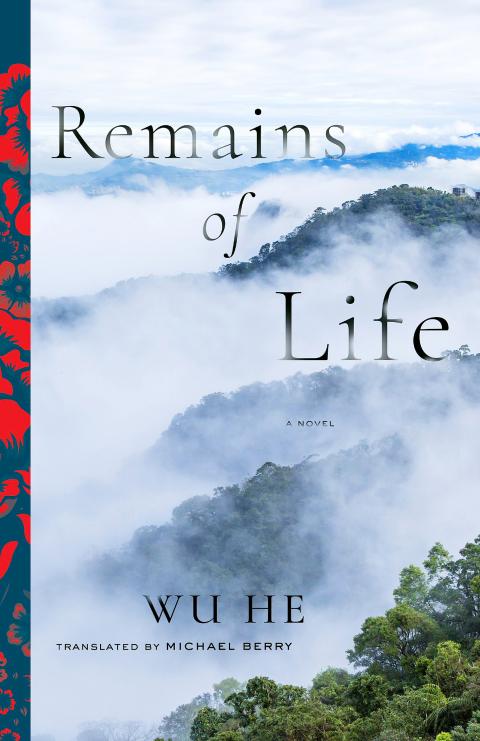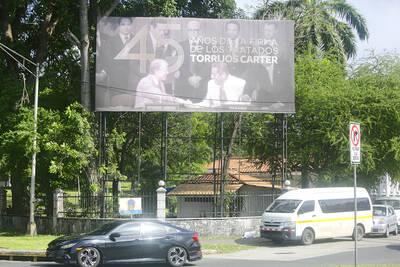Although the era of literary modernism has strictly passed in the West, some in Taiwan’s literary circles continue to hope for a masterpiece in the style to appear in Chinese, comparable perhaps to Joyce’s Ulysses. When Yu Sheng (餘生), published in English last month as Remains of Life, appeared in 1999, many thought the miracle had finally happened. Its subject is the Wushe Incident.
This was the massacre of 134 Japanese at the Wushe’s elementary school’s sports ground on Oct. 27, 1930 by the Atayal community. It was followed, beginning the next day, by a Japanese assault on the Atayal with heavy artillery, bombs (including experimental incendiary bombs) and an internationally banned poison gas that resulted in the reduction of the group from around 1,200 to some 500.
A third attack took place on April 25, 1931 in the form of another Japanese assault, this time on a detention center, in which almost 200 more Aborigines were killed, with over 100 of them decapitated. The Atayal survivors were forcibly moved to a site 40km from Musha known today as Qingliu, formerly called Chuanzhongdao, or Riverisle. These survivors are the origin of the term “remains of life.”

Taiwanese author Wu He (舞鶴; real name Chen Kuo-chang, 陳國城) went to Qingliu in the 1990s to investigate these events and try to find descendants of those involved. The eventual result was this stream-of-consciousness novel, now translated into English by Michael Berry.
The original book received critical acclaim in Taiwanese and other literary circles, formed the basis of a two-part film Warriors of the Rainbow: Seediq Bale (彩虹戰士:賽德克巴萊, 2011) and a documentary two years later called Pusu Qhuni (餘生—賽德克·巴萊). It was translated into French as Les Survivants, also in 2011.
A sensation the original may have been, but it doesn’t make for easy reading in English. There are no paragraph breaks anywhere in the entire book, and only a handful of periods. The narrating voice veers widely, from philosophical speculation as to what makes human beings capable of such violence to incidents the author experienced in Qingliu. Tamsui, where the author lived for many years, also features — he writes of “watching the colors of night move in on the nearby mountains and river” there. But the translator in his Introduction twice calls it “a difficult text,” and even goes as far as to refer to Wu He’s “sometimes nonsensical ramblings,” and passages in the book that he found “challenging or just plain weird.”
It’s true that there are attempts to discriminate between the inhumanity of the original massacre, its worth as an act of resistance and the status, heroic or otherwise, of its leader Mona Rudao and it’s being in the Aboriginal tradition of a ritual head-hunt. But such an analytical approach doesn’t dominate. Instead, what we have is an experimental novel whose stream-of-consciousness isn’t the ideal format for a balanced historical evaluation.
Nevertheless, at one point the run-up to the 1930 Wushe Incident is outlined — the unsuccessful 1911 attempt by the Japanese to get the Aborigines to give up their arms and ammunition (perceived as an assault on the dignity of a hunting culture), the order the same year for them to hand over all collections of human skulls, the 1916 prohibition of opium consumption, the 1917 prohibition of tattooing, the 1918 command insisting on short hair for men and the outlawing of the traditional practice of deforming the front teeth of adolescents and the 1922 banning of indoor burials. Then, in 1926, the Atayal handed over 1,319 rifles and 8,086 bullets to the authorities. Clearly the advice of one of the first Japanese to set foot on Taiwan was being followed: “If you want to colonize the island of Taiwan,” he’d said, “you must first tame the wild savages.”
Wu He certainly never comes to any conclusions about the Wushe Incident and what followed. He says, in one of many rambling, discursive pages, that he feels the time has come for conclusions, and hints at a few: that many Aborigines refused to take part, so the issue was controversial even before the first massacre happened, and that the state of affairs prior to 1930 was not so dire that the very existence of the communities was threatened.
But there is nothing final about such thoughts, and indeed Wu He writes that he wishes that “during my walks round this island nation I was able just to deeply observe and didn’t have to take any notes, raise any criticisms, or offer any conclusions.” There’s something very American about this, calling to mind Melville, Whitman or Thoreau, and, of course, it’s also an attitude that tends towards the literary rather than the historical. After all, no informed reappraisal of the Wushe Incident would be hailed as literature in the way Remains of Life in its original Chinese form has been.
Traditional novels contain a chronologically-developed plot and characters who are defined, among other things, by the way they speak, and Joyce retained elements of both in Ulysses. There is no trace of a developing plot in this book, however, but there are characters — among them Girl, a grand-daughter of Mona Rudao; an affectionately depicted half-wit initially called Mr Weirdo but later referred to as Deformo; and a Buddhist nun, simply called Nun, who has set up a makeshift shrine in a freight container on mountain land designated by the government as out-of-bounds.
My conclusion about this novel is that, a classic though it may well be in Chinese, it doesn’t quite have that quality in English. Reading it didn’t give me much pleasure, for instance, and great literature always gives pleasure. But it’s important that such a major work in contemporary Taiwanese fiction should be accessible to English readers so we can at least have some idea of what all the fuss is about. And maybe some readers will get more from it than I did. Even so, anyone embarking on Remains of Life should be prepared at the very least for a rough ride. I wasn’t that surprised to read that Michael Berry took over 10 years to complete this translation.

April 14 to April 20 In March 1947, Sising Katadrepan urged the government to drop the “high mountain people” (高山族) designation for Indigenous Taiwanese and refer to them as “Taiwan people” (台灣族). He considered the term derogatory, arguing that it made them sound like animals. The Taiwan Provincial Government agreed to stop using the term, stating that Indigenous Taiwanese suffered all sorts of discrimination and oppression under the Japanese and were forced to live in the mountains as outsiders to society. Now, under the new regime, they would be seen as equals, thus they should be henceforth

Last week, the the National Immigration Agency (NIA) told the legislature that more than 10,000 naturalized Taiwanese citizens from the People’s Republic of China (PRC) risked having their citizenship revoked if they failed to provide proof that they had renounced their Chinese household registration within the next three months. Renunciation is required under the Act Governing Relations Between the People of the Taiwan Area and the Mainland Area (臺灣地區與大陸地區人民關係條例), as amended in 2004, though it was only a legal requirement after 2000. Prior to that, it had been only an administrative requirement since the Nationality Act (國籍法) was established in

Three big changes have transformed the landscape of Taiwan’s local patronage factions: Increasing Democratic Progressive Party (DPP) involvement, rising new factions and the Chinese Nationalist Party’s (KMT) significantly weakened control. GREEN FACTIONS It is said that “south of the Zhuoshui River (濁水溪), there is no blue-green divide,” meaning that from Yunlin County south there is no difference between KMT and DPP politicians. This is not always true, but there is more than a grain of truth to it. Traditionally, DPP factions are viewed as national entities, with their primary function to secure plum positions in the party and government. This is not unusual

US President Donald Trump’s bid to take back control of the Panama Canal has put his counterpart Jose Raul Mulino in a difficult position and revived fears in the Central American country that US military bases will return. After Trump vowed to reclaim the interoceanic waterway from Chinese influence, US Defense Secretary Pete Hegseth signed an agreement with the Mulino administration last week for the US to deploy troops in areas adjacent to the canal. For more than two decades, after handing over control of the strategically vital waterway to Panama in 1999 and dismantling the bases that protected it, Washington has